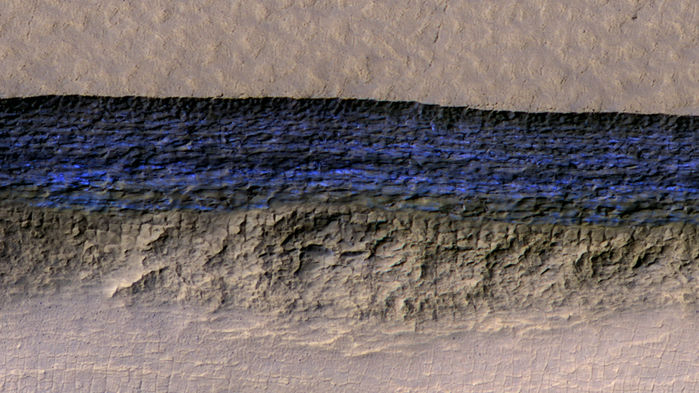
Enhanced color image of the thick bands of ice (blue) have been spotted in steep cliff faces. NASA/JPL/UNIVERSITY OF ARIZONA/USGS
At last week’s journal club, we discussed a recent paper that reports the discovery of ancient glaciers on Mars.
Dr. Colin Dundas of the USGS’s Astrogeology Group based in Flagstaff spotted these buried ice cliffs during his daily scan of the regularly collected images taken by the HiRISE camera onboard Mars Reconnaissance Orbiter (MRO) currently circling Mars. (The camera itself is pretty stunning – it produces orbital images of Mars at high enough resolution that you could almost read the headline on a martian newspaper, assuming they had newspapers.)
In scanning through the daily haul of images, Dundas spotted striking blue strata in the walls of steep cliffs just a few meters below the dusty martian surface that sure look like water ice. Follow-up spectral observations by CRISM instrument on MRO confirmed the cliffs were indeed almost completely pure water ice, with no more than with less than 1% dust.
Ice on Mars isn’t particularly surprising – astronomers have known (or at least suspected) there is water ice at the poles of Mars for more than 100 years, and a mountain of data has indicated vast stores of ice in Mars’ subsurface, especially near the poles. But key questions about this ice have persisted: Was the ice recently deposited, and how much dust is mixed in?
Since these newly discovered cliffs are so pure, though, Dundas and colleagues suggest that they were probably deposited as snow before being buried. Mars’ current climate isn’t really conducive to water snow, and so the ice was probably deposited millions of years ago, when Mars’ axis had a very different tilt resulting a very different climate from now. The fact that the ice cliffs occur much nearer to the equator than might be expected also points to formation during a previous climatic epoch.
The implications of these cliffs for Mars’ climate history aren’t entirely clear, but their importance for exploration of Mars is hard to overstate. As Dundas et al. say in their paper, the cliffs would very likely serve as a resource for future human visitors. The water could be combined with gases in the martian atmosphere to make rocket propellent and even oxygen.
So there are large deposits of ice in the subsurface of Mars? Maybe “Total Recall” wasn’t so much science fiction as science prophesy.